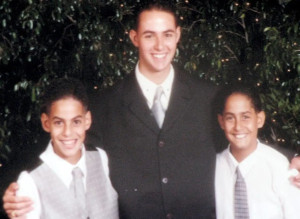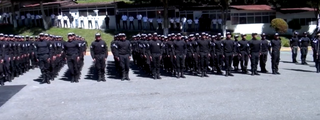
Municipalities of Venezuela are subdivisions of the States of Venezuela. There are 335 municipalities dividing the 23 states and the Capital District.

El Hatillo Municipality is an administrative division of the State of Miranda, Venezuela; along with Baruta, Chacao, Libertador and Sucre, it is one of the five municipalities of Caracas, the capital of Venezuela. It is located in the southeastern area of Caracas, and in the northwestern part of the State of Miranda.

The Francisco Fajardo Highway is the most important freeway of Caracas, connecting the west and east sides of the city. The national freeways and many of the avenues of Caracas are not designated with a system of codification or numbering; instead they are designated with the names of historical personages. This highway is named for the conquistador Francisco Fajardo. Also in Caracas, the connections between freeways are also given peculiar names - the octopus, the spider and the centipede are examples.

Municipal elections were held in Venezuela on 10 December 2017, to elect 335 mayors throughout Venezuela, as well as the governor of the state of Zulia. This was the first municipal election held since 2013, when elections were delayed from 2012 following the death of Hugo Chávez. The election resulted in many members of the United Socialist Party of Venezuela being elected as heads of municipal governments throughout Venezuela.

The El Junquito raid was a police and military raid that occurred on 15 January 2018 in El Junquito, Capital District, Venezuela, which resulted in the death of rebel Óscar Alberto Pérez and members of his movement.

The Sabana Grande district is divided into several middle class neighborhoods located in the Parroquia El Recreo of the Libertador Municipality, in the geographical center of the Metropolitan District of Caracas and owes its name to the old town of Sabana Grande.

The El Paraíso stampede was a stampede of more than 500 people that occurred in the early-morning hours of 16 June 2018 at the El Paraíso Social Club, also known as Los Cotorros Club, in the El Paraíso urbanization in Caracas, Venezuela. The stampede was the result of a tear gas canister being detonated during a brawl among a group of students from different schools celebrating their proms. At least 19 people died, and according to official police reports, they were caused by asphyxia and polytrauma.

The attack on Fort Paramacay, code name Operation David, was a military assault carried out in the morning of Sunday, August 6, 2017, between 3:50 a.m. and 8:00 a.m. in the Venezuelan town of Naguanagua, Carabobo.
Fernando Alberto Albán Salazar was a Venezuelan–Colombian activist, lawyer, politician, and prominent figure within the Justice First opposition party. Albán served as a councilman of the Libertador Municipality of Caracas from 2012 until his death in office in 2018.

The Homeland card is a Venezuelan identity document that includes a unique personalized QR code. It was created in 2016 by the Venezuelan government with the objective of knowing the socioeconomic status of the population and streamlining the system of the Bolivarian missions and that of the local committees of supply and production (CLAP).

A group of inmates were involved in a prison riot on 24 May 2019 in the police station cellblocks in Acarigua, Portuguesa state, Venezuela. The riot allegedly began when inmate Wilfredo Ramos was killed following ten days of protests against the denial of visits by relatives.

The Faddoul Brothers were three young Venezuelans, children of a Canadian-Lebanese businessman, who were kidnapped on 23 February 2006 in Caracas, along with their driver Miguel Rivas. The bodies of the four were subsequently found on 4 April 2006. The murder of the brothers caused outrage throughout Venezuela and mass protests occurred in Caracas against crime in Venezuela.

Fuerte Tiuna or Fort Tiuna is the name given to one of the most recognized military installations in the city of Caracas and the South American and Caribbean country of Venezuela.

On 9 November 2019, four teenagers were killed and over 50 people were injured in a human stampede at a trap music concert in Caracas.

The COVID-19 pandemic in Venezuela was a part of the worldwide pandemic of coronavirus disease 2019 caused by severe acute respiratory syndrome coronavirus 2. The first two cases in Venezuela were confirmed on 13 March 2020; the first death was reported on 26 March. However, the first record of a patient claiming to have symptoms of coronavirus disease dates back to 29 February 2020, with government officials suspecting that the first person carrying the virus could have entered the country as early as 25 February.

The Guanare prison riot, also known as the Guanaremassacre, occurred in the Los Llanos prison in Guanare, Portuguesa state, Venezuela, on 1 May 2020. The events caused around 47 deaths, and 75 people were injured.

The La Vega raid was a police raid that occurred on 8 January 2021 in La Vega Parish, Caracas, Venezuela. The objective of the raid was to take control of La Vega Parish, which was controlled by a criminal organization, led by Leonardo José Polanco Angulo; he was a drug lord, known as "El Loco Leo". Members of the Venezuelan National Police (PNB), the Special Action Forces (FAES) and the Venezuelan National Guard seized control of the parish, killing a number of people in the neighborhood. According to investigative journalists and human rights organizations, the death toll was 23 people. By 11 January, no member of the Nicolás Maduro administration had made a statement about the events or announced a death toll.

The Special Action Forces is an elite command of the Venezuelan National Police created in April 2016. By 2019, it had around 1,300 officers. The FAES includes the Unidad de Operaciones Tácticas Especiales (UOTE) a police tactical unit. The FAES have been accused of being a political instrument of Nicolás Maduro, as well as being a death squad and of repressing the opposition.




















